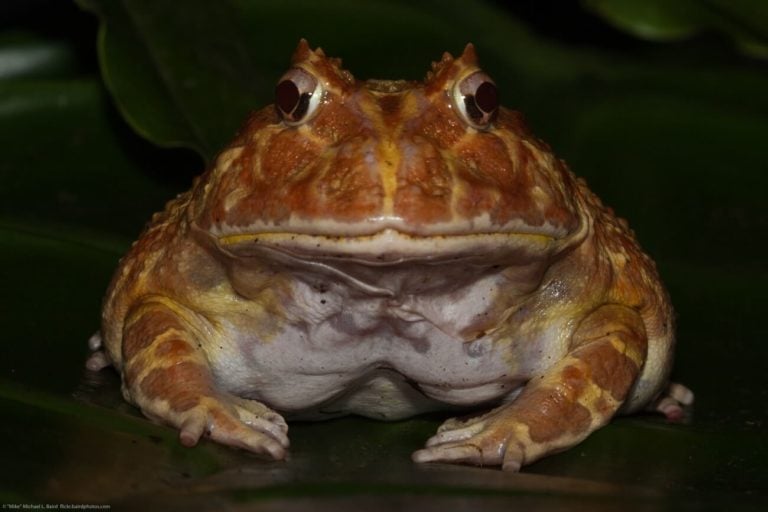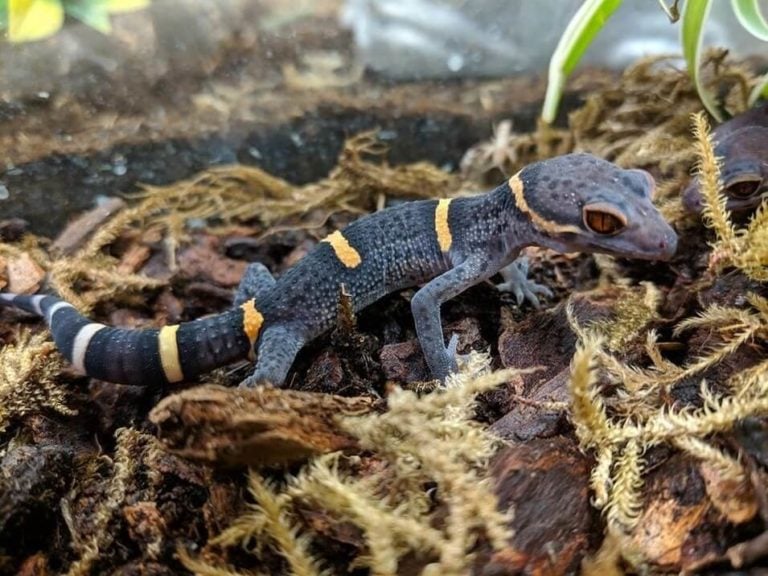Frog-eyed geckos are unique lizards that can be quite rewarding to care for. But they can be challenging!
These reptiles have some uncommon requirements that make them a bit tricky to deal with (especially if you haven’t done your homework). However, if you’re up to the task the process is incredibly rewarding.
This guide will cover everything you need to know about frog-eyed gecko care. From their diet to the ideal habitat setup, we have you covered!
Table of Contents
Species Summary
The frog-eyed gecko (Teratoscincus scincus) is a quirky ground-dwelling lizard you don’t see very often in the reptile trade. Compared to its more popular gecko cousins, this species is a rare commodity. Not only is frog-eyed gecko care a bit more challenging, but its lifestyle and needs are dramatically different than what most would expect from another species.
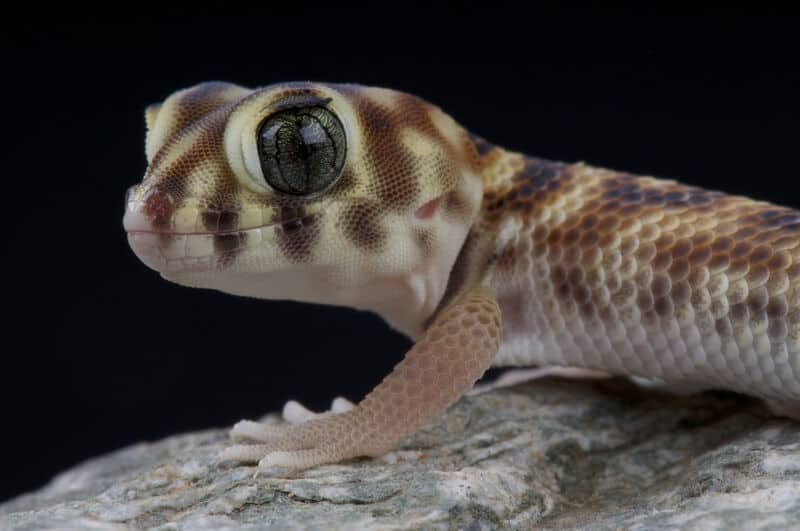
Instead of lush, humid jungles, the frog-eyed gecko hails from arid environments in Asia and the Middle East. It evolved to thrive in dunes and gravel plains. As a result, many of the standard herpetology conventions don’t apply to this lizard!
If you’re lucky enough to get your hands on a frog-eyed gecko, you have a big challenge ahead of you. However, the work is well worth the effort to call this unique animal your own.
Appearance & Colors
Take one look at the frog-eyed gecko, and you’ll immediately notice that it’s not built for environments with tons of vegetation.
The body is covered in scales. The scales are small and intricate on the head. However, they get progressively larger as you inch towards the tail. This unique body armor helps the lizard absorb water, which is a scarce necessity in their natural environment.
This species lacks the sticky toe pads that you see on many other types of geckos. Instead, each digit features comb-like scales for moving through sandy environments.
Expert Tip: The frog-eyed gecko gets its colorful name from the distinct appearance of the head. Compared to its size and build, this lizard’s head is quite broad. It also has large, bulging eyes that many compare to frogs.
The rest of the body is stout, too. The gecko’s tail is short, as it doesn’t need to use it for balance like other species. The frog-eyed gecko is also sporting long and robust limbs for getting through the sand.
When it comes to color, the frog-eyed gecko is pretty muted. Most of the body is yellow-brown. Black-brown stripes break up the solid color and provide some visual interest. You might see sporadic lines, random patches of dark color, and spots.
Like most reptiles, the belly is much lighter. On this species, it’s white and usually devoid of any patterns.
Lifespan
There’s no way to guarantee an animal’s lifespan in captivity. Several factors can impact longevity. For the frog-eyed gecko, a species that’s difficult to care for, even more variables come into play!
That said, the life expectancy for these lizards in pristine living conditions is quite long. The average frog-eyed gecko lifespan can be anywhere between 12 and 20 years.
Providing proper frog-eyed gecko care is essential if you want to improve the chances of your pet living a long and healthy life. Failing to address the gecko’s needs could result in disease and premature death.
Average Size
These geckos aren’t very big at all. The average size of a frog-eyed gecko can be anywhere from five to seven inches in length.
However, most specimens hover around six inches. While they can get a bit bigger, seeing frog-eyed geckos over six inches long is rare. It takes a rare combination of great care and good genetics to see one reach this length.
Frog-Eyed Gecko Care
There’s a reason why you don’t see these geckos kept as pet lizards very often.
As we mentioned earlier, frog-eyed gecko care is more difficult than your average gecko or pet lizard. They have distinct needs that you can’t ignore.
The good news is that they’re perfectly manageable once you have a good grasp of the basics. To help you on your journey to raising frog-eyed geckos, here are some basic care guidelines you don’t want to miss.
Enclosure Size
The first thing to consider is the size of the enclosure. Because they’re so small, frog-eyed geckos don’t need massive habitats to stay happy.
A single gecko or bonded pair can live in a standard 10-gallon glass tank. However, we recommend going with a 20-gallon model if possible.
If you’re using a reptile vivarium or custom-made habitat, go for a design that’s at least 30 inches wide, 12 inches long, and 12 inches tall. These reptiles do well in both wooden vivariums and modified aquariums.
Expert Tip: However, one of the most critical features to look for is proper ventilation. We’ll go over humidity requirements later, but for now, you need to ensure that the habitat has enough airflow to keep moisture levels low.
Habitat Setup
As with any other reptile, frog-eyed geckos do best when kept in habitat setups that mimic their natural environment. In this case, that would be desert-like decor.
Start with a layer of a dry substrate. Most agree that store-bought sands are a no-go. You want to avoid anything with calcium in it or a product that’s formulated to retain moisture.
Sand and clay mixtures work best. You can also go for a chunkier material like oil-free beechwood chips.
On top of the substrate, provide a few enrichment items and hide structures. Artificial caves, cut PVC pipes, flat cork pieces, and more work well. It’s good to include several shelter areas in different areas of the enclosure to give the gecko options.
Expert Tip: For heat and comfort, try putting some natural slate rocks in the environment as well. Slate retains heat, which helps the gecko stay warm.
Temperature & Lighting
Despite living in conditions similar to that of a desert, frog-eyed geckos aren’t from super hot climates. They like heat, but they prefer to have modest ambient temperatures and plenty of places to escape the warmth when they get too hot. If you want to provide excellent frog-eyed gecko care, it’s crucial to keep this in mind.
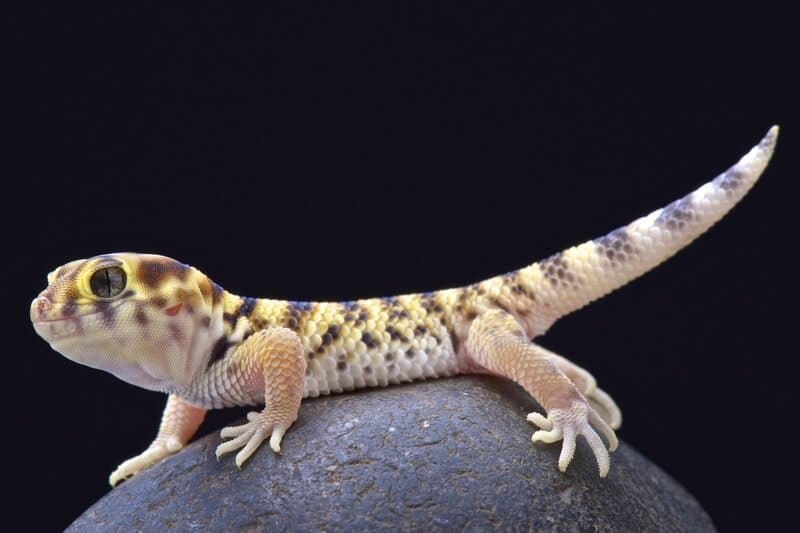
These lizards thermoregulate by moving to different areas of their environment. So, you must create a temperature gradient to facilitate that behavior.
Here are the main temperature values to remember:
- On one end of the tank, use a basking light to create a hot area of around 90 degrees Fahrenheit.
- The cooler end should be between 76 and 81 degrees Fahrenheit.
Expert Tip: A bit of fluctuation is fine as long as the variances don’t go beyond five degrees.
If you live in a colder part of the world, you may have to use heat emitters to keep temperatures stable at night. Automatic heaters can maintain the environment and ensure that the temperature doesn’t drop below 75 degrees.
Frog-eyed geckos need a clear day and night cycle. So, make sure to turn off all the lights at night. If you must see the gecko, use red lamps to prevent accidental disruption.
As for daytime lighting, you don’t need much. Many owners prefer to let natural sunlight do the illumination beyond the basking lamp.
Frog-eyed geckos aren’t full-time basking lizards either, so a UVB lamp isn’t always necessary. Whether or not you use one depends on how you position the tank. If it’s close to a window, you can forgo the lamp.
But if it doesn’t get any natural light, your gecko may benefit from a small UVB lamp with two to seven percent intensity. That’s all these geckos need.
Humidity
Frog-eyed geckos are rare exceptions when it comes to their humidity requirements. Unlike most reptile species, these guys don’t require a ton of moisture in the air to survive. In fact, they thrive in low-humidity environments.
There’s no exact percentage to aim for in their habitat after. However, the consensus is that 30 percent and lower is ideal.
To achieve that humidity level, use a low-absorption substrate and provide plenty of ventilation. It’s important to keep a hygrometer in the tank to stay on top of humidity levels. If the humidity gets too high, aerate the habitat to promote evaporation.
Water
This gecko pulls moisture from the air and the substrate. It’s not much, but their bodies are primed to collect all the water they need.
That said, it’s still a good idea to provide a small or medium-sized water dish. Use a shallow bowl that’s big enough for the lizard to crawl into.
You’ll rarely see them lapping up water as a drink. However, many will utilize the dish for soaking and bathing. Some might defecate in the bowl, too.
When that happens, clean up the mess as soon as possible to limit bacterial spread. Always keep the bowl filled with fresh and clean water. The owners who provide the best frog-eyed gecko care are all committed to cleanliness in the enclosure (and that starts with water).
Food & Diet
Insects are the name of the game when it comes to the diet of frog-eyed geckos. They thrive on a diet of pure protein!
The best foods to feed these lizards are live crickets, mealworms, and beetle grubs.
Waxworms, calciworms, locusts, and Dubia roaches work well, too. However, many frog-eyed gecko owners recommend being a little more stingy with the fattier foods. The same goes for roaches, which can be difficult for younger geckos to digest.
Expert Tip: Frog-eyed geckos need to eat four to five times per week depending on their size and age. To avoid potential health problems, dust the insects with calcium and Vitamin D3 powder supplements.
Potential Health Issues
The frog-eyed gecko is susceptible to a wide range of health problems. There’s a risk that your lizard will suffer from any of the common reptile ailments (even when you’ve provided great care). That includes respiratory issues, bacterial infections, and bone disorders.
Respiratory troubles tend to be more widespread with this species. It occurs when humidity levels and temperatures aren’t where they need to be. The lining of the throat and nose become inflamed, leading to discharge, swelling, and pain.
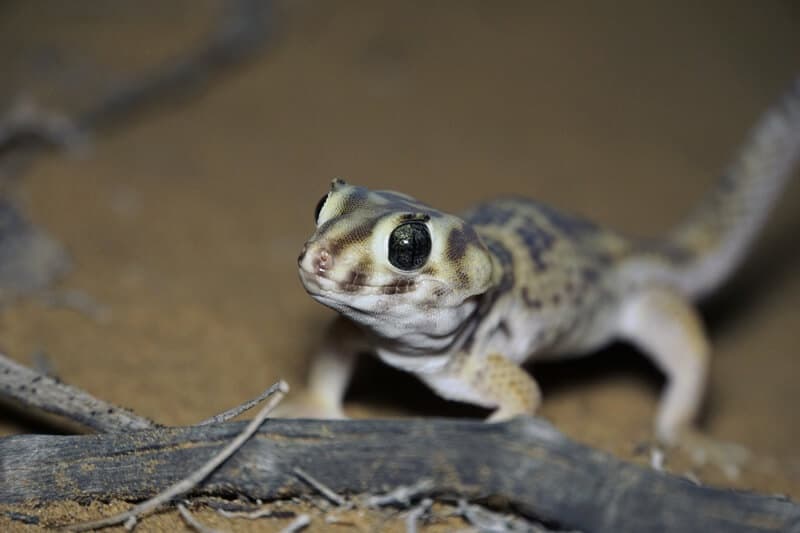
Fortunately, respiratory issues are easy to avoid when you stay on top of habitat conditions.
Bone diseases are a product of inadequate calcium synthesis. Frog-eyed geckos don’t like to bask in the sun as much as other lizards, so you have to supplement their calcium intake through food. Make sure to dust gut-loaded insects with the vitamins and minerals they need.
Otherwise, their bones may become frail and prone to breakage.
Finally, there are bacterial infections. Bacteria is the scourge of any reptile tank. There’s no way to avoid bacteria altogether. But, you can do your part to keep the habitat as clean and germ-free as possible.
Spot clean messes, replenish the water supply, and pick up waste regularly. About once a month, do full-fledged sanitation. Remove every piece of decor and spray all surfaces down with a reptile-safe disinfectant before rebuilding the habitat.
Establish a consistent cleaning schedule to prevent major bacterial problems in the future.
Behavior & Temperament
Frog-eyed geckos are notoriously skittish. They’re easy to provoke and will often exhibit defensive strategies when stressed.
Expert Tip: If the lizard feels that its safety is compromised, it will stand on its toes, arch its back like a cat, and adopt a menacing facial expression. The gecko will resort to tail lashing if the threat continues.
Males and females can usually cohabitate in peace. However, males should never live in the same enclosure.
Male frog-eyed geckos are prone to fighting. When this happens, you’ll see and hear a lot of aggression. These geckos squeal, produce hissing noises, and more. During a fight, frog-eyed geckos will also drop their tail.
It’s best to keep the peace and prevent male-to-male interaction. In most instances, a single bonded pair will coexist peacefully without too many issues.
Handling Them
This species isn’t too keen on handling. Keep handling to only moments when it’s necessary.
Attempting to hold a frog-eyed gecko for fun will often result in shed scales and a dropped tail. The lizard may also resort to biting if you don’t let it free. Bites don’t pierce human skin, but they can cause some uncomfortable rashes.
If you must hold a frog-eyed gecko, do so gently. Let it settle in your hand naturally and give it free rein to move around. Quickly transfer it to another container and don’t perform too many restraining moves.
Frog-eyed geckos are best appreciated through the glass of the enclosure. They’re not a species you want to hold frequently.
Conclusion
Frog-eyed gecko care can seem a bit intimidating at first, but it’s doable once you familiarize yourself with their requirements. And besides, the unique nature of these lizards is all part of the fun!
If you have any questions about these geckos that weren’t answered in the guide above, send us a message. We’re always happy to help.

